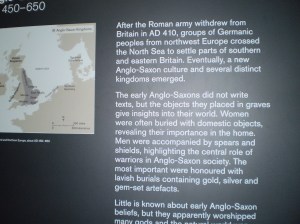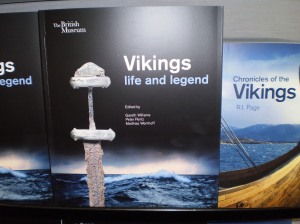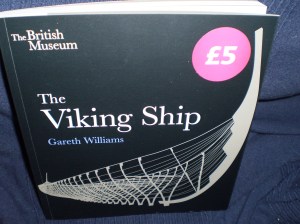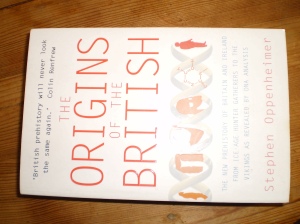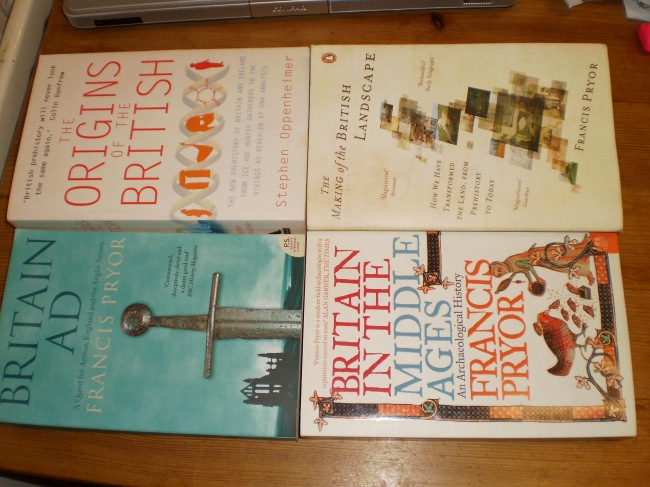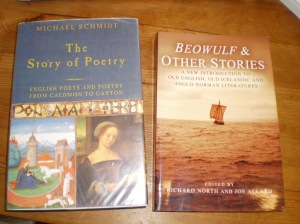
The only surviving copy of this poem is in the Exeter Book manuscript, so, like ‘Wulf and Eadwacer’ and ‘The Wife’s Lament’ which I looked at in earlier posts, this poem was written more than a 1000 years ago (and perhaps originally composed considerably earlier – the tenth century is the date of the manuscript, but we know nothing about how any of these poems came to be within it).
Once again the poem has a narrator, so we have a clear feeling that this lonesome traveller / pilgrim / exile is speaking to us across the ages. The poem contains the musings of a seafarer, currently on land, vividly describing difficult times at sea. The paradox is that despite the danger and misery of previous sea voyages he desires to set off again. Remember though, that there are other ways of interpreting/ translating this poem.
Most Old English scholars have identified this as a Christian poem – and the sea as an allegory for the trials of a Christian seeking his God. If you only read the first half of the poem you won’t come to this conclusion, as it appears to describe real sea travel, together with memories of the narrator’s lost time as an Anglo-Saxon warrior (well that’s one way of interpreting these lines). From about half way through the poem the narrator starts to refer to his Lord/god, and we begin to view the first half of the poem in a different light.
The last part of the poem contains a more conventional homily praising the seafarer’s (Christian) god and advising followers how to conduct their lives in order to reach heaven. This ending seems quite different in tone (and originality and hence poetic quality) from that which goes before – early translators often excluded this part from their translations of ‘The Seafarer’, considering it to be a separate poem.
I do appreciate the religious side of the poem, although I am not ‘religious’ myself (like many 50+ people in Britain I was brought up within the Christian tradition – I love cathedrals and old village churches, rituals like harvest festival, the Bible with its wonderful language and stories, hymns we sung at school as a child etc). However, what I really love about this poem is the images of the sea and the birds, and how the seafarer shares his memories, feelings and longings with the reader. It makes you want to know more about the poet, and the character in the poem that he speaks through.
In this poem there is no church, no tradition, no priest telling you what to believe – it’s a time when Christians were in a minority and followers were genuine pilgrims searching for ‘truth’ and this appears to be one aspect of the poem, but a love of the sea and nature also comes through very clearly. You want to know more about this person, and about the poet. As usual with the Old English poems ‘The Seafarer’ leaves you with many questions that will never be answered, but this means you have a chance to reach your own conclusions on what it’s about – like all good poetry.
The poem is 125 lines long – I have included all of it here but you’ll have to do a bit of scrolling to get through it (first in Old English, then in translation into modern English). As in my previous posts I’m using the edition of the poem from The Anglo-Saxon Poetic Records edited by G.P. Krapp and E.V.K. Dobbie in 1936, and the translation from Richard Hamer’s 1970 anthology, A Choice of Anglo-Saxon Verse. You’ll find if you look at other translations that each one of them provides a different interpretation of what is happening, and hence a very different poem / story.
The original manuscript has no punctuation as we understand it (a few random dots are scattered about, but modern editors have identified no purpose for them) and no capitals to signal proper nouns. It is not even set out in ‘lines’ of verse. Editors have to add these layers of meaning, and each editor makes different decisions.
There are also a few words that are indecipherable towards the end of this poem, where the manuscript has been damaged, so editors leave gaps or guess the words from the few letters they think they can identify (they use a lot of technology to examine the manuscripts – as you can imagine given the world we live in); translators usually fill in the gaps with what seems to make the most sense.
There are links to a couple of online versions here:
http://www.anglo-saxons.net/hwaet/?do=get&type=text&id=Sfr
http://faculty.arts.ubc.ca/sechard/oeseaf.htm
You could also try using Google Books or Amazon to look at some of the many books of Old English poetry, or even a library or a bookshop (not quite yet extinct!). You can listen to the poem spoken in Old English on YouTube, just to give you a flavour of the language – it sounds a bit like a cross between German and English.
(Untitled in manuscript)
Mæg ic be me sylfum soðgied wrecan,
siþas secgan, hu ic geswincdagum
earfoðhwile oft þrowade,
bitre breostceare gebiden hæbbe,
gecunnad in ceole cearselda fela,
atol yþa gewealc, þær mec oft bigeat
nearo nihtwaco æt nacan stefnan,
þonne he be clifum cnossað. Calde geþrungen
wæron mine fet, forste gebunden,
caldum clommum, þær þa ceare seofedun
hat ymb heortan; hungor innan slat
merewerges mod. þæt se mon ne wat
þe him on foldan fægrost limpeð,
hu ic earmcearig iscealdne sæ
winter wunade wræccan lastum,
winemægum bidroren,
bihongen hrimgicelum; hægl scurum fleag.
þær ic ne gehyrde butan hlimman sæ,
iscaldne wæg. Hwilum ylfete song
dyde ic me to gomene, ganetes hleoþor
ond huilpan sweg fore hleahtor wera,
mæw singende fore medodrince.
Stormas þær stanclifu beotan, þær him stearn oncwæð
isigfeþera; ful oft þæt earn bigeal,
urigfeþra; ne ænig hleomæga
feasceaftig ferð frefran meahte.
Forþon him gelyfeð lyt, se þe ah lifes wyn
gebiden in burgum, bealosiþa hwon,
wlonc ond wingal, hu ic werig oft
in brimlade bidan sceolde.
Nap nihtscua, norþan sniwde,
hrim hrusan bond, hægl feol on eorþan,
corna caldast. Forþon cnyssað nu
heortan geþohtas, þæt ic hean streamas,
sealtyþa gelac sylf cunnige;
monað modes lust mæla gehwylce
ferð to feran, þæt ic feor heonan
elþeodigra eard gesece.
Forþon nis þæs modwlonc mon ofer eorþan,
ne his gifena þæs god, ne in geoguþe to þæs hwæt,
ne in his dædum to þæs deor, ne him his dryhten to þæs hold,
þæt he a his sæfore sorge næbbe,
to hwon hine dryhten gedon wille.
Ne biþ him to hearpan hyge ne to hringþege,
ne to wife wyn ne to worulde hyht,
ne ymbe owiht elles, nefne ymb yða gewealc,
ac a hafað longunge se þe on lagu fundað.
Bearwas blostmum nimað, byrig fægriað,
wongas wlitigað, woruld onetteð;
ealle þa gemoniað modes fusne
sefan to siþe, þam þe swa þenceð
on flodwegas feor gewitan.
Swylce geac monað geomran reorde,
singeð sumeres weard, sorge beodeð
bitter in breosthord. þæt se beorn ne wat,
esteadig secg, hwæt þa sume dreogað
þe þa wræclastas widost lecgað.
Forþon nu min hyge hweorfeð ofer hreþerlocan,
min modsefa mid mereflode
ofer hwæles eþel hweorfeð wide,
eorþan sceatas, cymeð eft to me
gifre ond grædig, gielleð anfloga,
hweteð on hwælweg hreþer unwearnum
ofer holma gelagu. Forþon me hatran sind
dryhtnes dreamas þonne þis deade lif,
læne on londe. Ic gelyfe no
þæt him eorðwelan ece stondað.
Simle þreora sum þinga gehwylce,
ær his tid aga, to tweon weorþeð;
adl oþþe yldo oþþe ecghete
fægum fromweardum feorh oðþringeð.
Forþon þæt bið eorla gehwam æftercweþendra
lof lifgendra lastworda betst,
þæt he gewyrce, ær he on weg scyle,
fremum on foldan wið feonda niþ,
deorum dædum deofle togeanes,
þæt hine ælda bearn æfter hergen,
ond his lof siþþan lifge mid englum
awa to ealdre, ecan lifes blæd,
dream mid dugeþum. Dagas sind gewitene,
ealle onmedlan eorþan rices;
næron nu cyningas ne caseras
ne goldgiefan swylce iu wæron,
þonne hi mæst mid him mærþa gefremedon
ond on dryhtlicestum dome lifdon.
Gedroren is þeos duguð eal, dreamas sind gewitene,
wuniað þa wacran ond þas woruld healdaþ,
brucað þurh bisgo. Blæd is gehnæged,
eorþan indryhto ealdað ond searað,
swa nu monna gehwylc geond middangeard.
Yldo him on fareð, onsyn blacað,
gomelfeax gnornað, wat his iuwine,
æþelinga bearn, eorþan forgiefene.
Ne mæg him þonne se flæschoma, þonne him þæt feorg losað,
ne swete forswelgan ne sar gefelan,
ne hond onhreran ne mid hyge þencan.
þeah þe græf wille golde stregan
broþor his geborenum, byrgan be deadum,
maþmum mislicum þæt hine mid wille,
ne mæg þære sawle þe biþ synna ful
gold to geoce for godes egsan,
þonne he hit ær hydeð þenden he her leofað.
Micel biþ se meotudes egsa, forþon hi seo molde oncyrreð;
se gestaþelade stiþe grundas,
eorþan sceatas ond uprodor.
Dol biþ se þe him his dryhten ne ondrædeþ; cymeð him se deað unþinged.
Eadig bið se þe eaþmod leofaþ; cymeð him seo ar of heofonum,
meotod him þæt mod gestaþelað, forþon he in his meahte gelyfeð.
Stieran mon sceal strongum mode, ond þæt on staþelum healdan,
ond gewis werum, wisum clæne,
scyle monna gehwylc mid gemete healdan
wiþ leofne ond wið laþne bealo,
þeah þe he hine wille fyres fulne
oþþe on bæle forbærnedne
his geworhtne wine. Wyrd biþ swiþre,
meotud meahtigra þonne ænges monnes gehygd.
Uton we hycgan hwær we ham agen,
ond þonne geþencan hu we þider cumen,
ond we þonne eac tilien, þæt we to moten
in þa ecan eadignesse,
þær is lif gelong in lufan dryhtnes,
hyht in heofonum. þæs sy þam halgan þonc,
þæt he usic geweorþade, wuldres ealdor,
ece dryhten, in ealle tid.
Amen.
The Seafarer
I sing my own true story, tell my travels,
How I have often suffered times of hardship
In days of toil, and have experienced
Bitter anxiety, my troubled home
On many a ship has often been the heaving waves,
Where grim night-watch has often been my lot
At the ship’s prow as it beat past the cliffs.
Oppressed by cold my feet were bound by frost
In icy bonds, while worries simmered hot
About my heart, and hunger from within
Tore the sea-weary spirit. He knows not,
Who lives most easily on land, how I
Have spent my winter on the ice-cold sea,
Wretched and anxious, in the paths of exile,
Lacking dear friends, hung round by icicles,
While hail flew past in showers. There heard I nothing
But the resounding sea, the ice-cold waves.
Sometimes I made the song of the wild swan
My pleasure, or the gannet’s call, the cries
Of curlews for the missing mirth of men,
The singing gull instead of mead in hall.
Storms beat the rocky cliffs, and icy-winged
The term replied, the horn-beaked eagle shrieked.
No patron had I there who might have soothed
My desolate spirit. He can little know
Who, proud and flushed with wine, has spent his time
With all the joys of life among the cities,
Safe from such fearful venturings, how I
Have often suffered weary on the seas.
Night shadows darkened, snow came from the north,
Frost bound the earth and hail fell on the ground,
Coldest of corns. And yet the heart’s desires
Incite me now that I myself should go
On towering seas, among the salt waves’ play;
And constantly the heartfelt wishes uege
The spirit to venture, that I should go forth
To see the lands of strangers far away.
Yet no man in the world’s so proud of heart,
So generous of gifts, so bold in youth,
In deeds so brave, or with so loyal lord,
That he can venture on the sea
Without great fears of what the lord may bring.
His mind dwells not on the harmonious harp,
On ring-giving or on the joys of woman,
Or worldly hopes, or anything at all
But the relentless rolling waves;
But he who goes to sea must ever yearn.
The groves bear blossom, cities grow more bright,
The fields adorn themselves, the world speeds up;
Yet all this urges forth the eager spirit
Of him who desires to travel far
On the sea-paths. Likewise the cuckoo calls
With boding voice, the harbinger of summer
Offers but bitter sorrow in the breast.
The man who’s blest with comfort does not know
What some then suffer who most widely travel
The paths of exile. Even now my heart
Journeys beyond its confines, and my thoughts
Over the sea, across the whale’s domain,
Travel afar the regions of the earth,
And then come back to me with greed and longing.
The cuckoo cries, incites the eager breast
On to the whale’s roads irresistibly,
Over the wide expanses of the sea,
Because the joys of God mean more to me
Than this dead transitory life on land.
That earthly wealth lasts to eternity
I don’t believe. Always one of three things
Keeps all in doubt until one’s destined hour.
Sickness, old age, the sword, each one of these
May end the lives of doomed and transient men.
Therefore for every warrior the best
Memorial is the praise of living men
After his death, that ere he must depart
He shall have done good deeds on earth against
The malice of his foes, and noble works
Against the devil, that the sons of men
May after praise him, and his glory live
For ever with the angels in the splendour
Of lasting life, in bliss among those hosts.
The great old days have gone, and all the grandeur
Of earth; there are not Caesars now or kings
Or patrons such as once there used to be.
Amongst whom were performed most glorious deeds,
Who lived in lordliest renown. Gone now
Is all that host, the splendours have departed.
Weaker men live and occupy the world,
Enjoy it but with care. Fame is bought low,
Earthly nobility grows old, decays,
As now throughout this world does every man.
Age comes on him, his countenance grows pale,
Grey-haired he mourns , and knows his former lords,
The sons of princes, given to the earth.
Nor when his life slips from his body
Taste sweetness or feel pain or stir his hand
Or use his mind to think. And though a brother
May strew with gold his brother’s grave, and bury
His corpse among the dead while yet he lives,
Wishing them to go with him, yet can gold
Bring no help to the soul that’s full of sins,
Against God’s wrath, although he hides it here
Ready before his death while yet he lives.
Great is the might of God, by which earth moves;
For He established its foundations firm,
The land’s expanses, and the sky above.
Foolish is he who does not fear his Lord,
For death will come upon him unprepared.
Blessed is he who humble lives; for grace
Shall come to him from heaven. The Creator
Shall make his spirit steadfast, but his faith
Is in God’s might. Man must control himself
With strength of mind, and firmly hold to that,
True to his pledges, pure in all his ways.
With moderation should each man behave
In all his dealings with both friend and foe.
No man would wish the friend he’s made to burn
In fires of hell, or on an earthly pyre,
Yet fate is mightier, the Lord’s ordaining
More powerful than any man can know.
Let us think where we have our real home.
And then consider how we may come thither;
And let us labour also, so that we
May pass into eternal blessedness,
Where life belongs amid the love of God,
Hope in the heavens. The Holy One be thanked
That he has raised us up, the Prince of Glory,
Lord without end, to all eternity.
Amen
